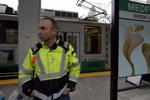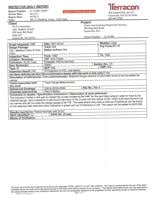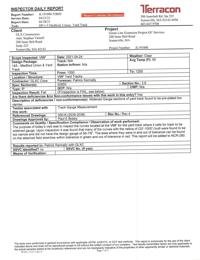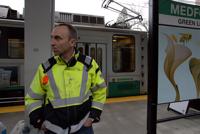Most Of New Green Line Tracks Need To Be Widened
Healey: Baker Admin Knew About Problem, Didn’t Disclose It

BOSTON, OCT. 19, 2023…..Problems with the MBTA’s new 4.4-mile Green Line Extension are so severe that the agency will need to widen more than two-thirds of the nearly brand-new tracks, officials announced Thursday, a stunning development that reveals construction and oversight failures.
MBTA General Manager Phil Eng, who was hired in April by Gov. Maura Healey, announced that an ongoing review determined roughly 50 percent of the Union Square branch and 80 percent of the Medford/Tufts branch will need to be “regauged” to increase the space between the two rails.
Eng said he learned the extent of the problems “recently,” but that other officials at the MBTA were or could have been aware about narrow tracks in 2021, or as early as 11 months before the first portion of the expansion opened to riders.
The problems appear linked to metal plates that connect the rails to the wooden ties that run perpendicular. Those plates — which were pre-installed off site before the rails were delivered to the MBTA — are too close together in many areas, Eng said.
In April 2021, the MBTA received an inspection report from a firm named Terracon warning that tracks in a railyard set to be used for the extension were too narrow, Eng said. It appears that MBTA officials at the time did not view that report as a red flag and did not respond by taking a closer look at the space between rails on actual construction sites.
More than a year later in November 2022 — when the Union Square branch had already opened and the larger Medford branch was about to open — a scan found 29 locations where rails were so narrow that trains would not be able to safely run at full speeds, plus a “significant portion” of tracks where the gauge was tighter than construction standards but not bad enough to warrant slow zones. The T fixed those 29 defects at the time, Eng said.
“There was tight gauge in this yard facility. That was back in April of 2021, We also had other reports in November of ’22 that indicated the widespread need to address more than just these isolated conditions,” Eng said. “Back in April of 2021, it’s my belief that it could have been, it should have been more proactively investigated prior to opening, prior to installing what we’ve done.”
It’s not clear why MBTA officials did not address the issue earlier. Steve Poftak served as MBTA general manager from January 2019 until January 2023, and Gov. Charlie Baker’s administration oversaw the T.
A redacted copy of an April 2021 inspection report that identified narrow track gauges on the MBTA’s Green Line Extension project.
“Once you identify a problem, it should be brought to everyone’s attention, even if you have a solution. It’s good to know because the sooner you know, the more chance you have to address it before it becomes a much more challenging thing. To fix it as part of the punch list, per se, is more challenging because of the impact to the public,” Eng said. “If you knew in April 2021 you could have proactively avoided this, I think that it’s in everyone’s best interest that is done because you don’t want to install something and only later have to fix it.”
Eng said GLX Constructors, the joint venture of contractors that built the rail expansion, was tasked with presenting a proposal to address the track problems.
He did not say how much the additional work to widen tracks up to construction standards would cost, nor make exact what kind of impact it would have on riders.
“It’s not going to be years, it’s not going to be months. The proposal that we have is weeks, and it’s something that we’re still reviewing,” he said. “Whether it’s this type of repair or others, how do we do it and minimize the impacts to our riders? Whether it’s overnights, whether it’s early access [closures], weekends, we understand the importance of this system, including the extension, to riders and we will make sure that when we have a proposal, we’re talking publicly about this as well.”
Eng suggested GLX Constructors should foot the bill for any additional work, not the T. A spokesperson said the agency will convene discussions with the builders as part of closing out the contract.
“This is not something that the public should be paying for, not going to pay for,” Eng said.
“The fix is not that difficult. I have faith that they can accomplish that,” he added about GLX Constructors.
Members of the GLX Constructors joint venture include Fluor Enterprises Inc., The Middlesex Corp., Herzog Contracting Corp. and Balfour Beatty Infrastructure Inc., according to a report about the project from the American Society of Civil Engineers.
Eng on Thursday also appointed Maureen McDonough, the MBTA’s chief of capital program support, as acting Green Line Extension Program Manager.
No other senior MBTA or administration officials spoke alongside Eng at a Thursday press conference. Neither Healey nor Transportation Secretary Monica Tibbits-Nutt attended the event.
“I share the public’s frustration and disappointment at the revelation that senior MBTA officials under the previous administration knew about issues with the Green Line Extension tracks years ago and did not disclose them to our administration or address them on their watch,” Healey said in a statement. “The people of Massachusetts deserve better. I applaud GM Eng for uncovering this and taking swift action to hold people accountable and demand a work plan from the contractor to fix the narrow gauges on their own dime. The MBTA is committed to fixing this and delivering the service that riders deserve.”
The problems exploded into public view last month, when the MBTA slashed speeds on about a combined mile of the Green Line Extension to 3 mph because the tracks were too narrow to safely support any faster travel.
Workers repaired those stretches in recent weeks, allowing the T to resume standard speeds across the Green Line Extension.

The project’s construction standards require a width between the rails of between 56 and seven-sixteenth inches and 56 and nine-sixteenth inches, Eng said Thursday. The threshold for slow zones is lower: anything below 56 and one-eighth inches is so narrow that it’s unsafe to run trains at full speed.
Officials said Thursday that although the entire Green Line Extension is above that 56 and one-eighth figure — and therefore able to travel safely at normal speeds — about a half-mile of track on the Union Square branch and 2.7 miles on the Medford branch have rail gauges narrower than 56 and seven-sixteenth inches, falling short of construction standards.
The $2.3 billion Green Line Extension opened in two phases last year to great fanfare and praise for project manager John Dalton. Gov. Charlie Baker claimed it as a victory after the project appeared on the brink of collapse years earlier.
Asked if his predecessors kept the problems quiet for political reasons, Eng replied, “I don’t have any indication of that. All I know is that I believe the team could have been more proactive.”





Baker as governor was a self serving failure. Under his 8 years, the T turned into a failure. Scandals in the state police and many other agencies were the norm. His replacement, Healey is even worse.
F#*@ING MBTA cronyism, fraud, waste, abuse, and incompetence is boundless. Railroads have known how to measure track width properly since the early 1800s. Our Transcontinental Railroad, for example, was built mostly by Irish and Chinese immigrant labor after the Civil War. The supervisors and engineers on that mammoth project knew how to measure track width properly, obviously. It’s not rocket science.
On the F#*@ING CORRUPT MBTA, not so much. Sleeping, watching TV, etc., is, however, encouraged–
https://www.bostonherald.com/2023/09/06/eight-mbta-employees-fired-for-sleeping-not-paying-attention-at-work/